
You need to know about the JN.1 variant of the new coronavirus
In less than four months, the JN.1 variant of the new coronavirus has become the dominant strain worldwide. The recent testing ratio is 94% in Hong Kong and 100% in Macau. The proportion of JN.1 in China’s coastal cities is also close to half . As there is less and less information related to the new coronavirus in China, most people may not know what is going on with JN.1.
An article from “Yale Medicine” – 3 Things to Know About the New Coronavirus Strain JN.1″ to briefly understand JN.1 and the recommendations of Yale Medicine experts. The following is a translation of the original text (abridged). [Article originally published on December 10, 2023, updated on January 4, 2024]
As the weather gets colder, flu, colds, and other seasonal respiratory viruses begin to spread. At the same time, the new coronavirus has been mutating and spreading. Recently, a strain called JN.1 has rapidly developed into the most widespread variant in the United States. Accounting for more than 60% of cases in early January.
The U.S. Centers for Disease Control and Prevention (CDC) predicts that JN.1 cases will continue to rise throughout the winter. The CDC said there is no evidence that JN.1 causes more severe disease. But its rapid spread suggests it is more transmissible or better able to evade the immune system than other circulating variants.
Dr. Heidi Zapata, an infectious disease expert at Yale University Medicine , said that the new crown epidemic has been rising overall (including infections from variants such as HV.1, which accounted for 14.8% of cases in early January). “I would say the most important thing for people to know is that COVID-19 is out there, as is RSV and influenza. Any new subvariant is a sign that COVID-19 is still evolving; it It’s still with us and we can’t ignore it. “
1. Where does JN.1 come from and what are the differences?
The JN.1 strain surfaced in the United States in September. It is a close relative of BA.2.86 (“Pirola”), a lineage of the Omicron variant that the CDC has been tracking since August. (While the Omicron variant that first became prevalent in the United States in 2021 has had multiple descendants, the original strain is no longer circulating.)
The difference between BA.2.86 and JN.1 is that the latter has a mutation in its spike protein, a change that may or may not ( utter nonsense ) change any characteristics of the virus, although preliminary research suggests it may provide Additional immune evasion.
2. What do we know and what don’t we know about JN.1?
Although there is not enough evidence yet, JN.1 does not appear to cause more cases of severe illness or symptoms that differ from those associated with previous strains. The CDC notes that symptoms caused by different variants often tend to be similar, and symptoms and severity often depend more on a person’s immunity than the variant.
A striking feature of JN.1 is its rapid evolution. According to expert estimates, after JN.1 first emerged in the United States in September. Its proportion rose from 3.5% in mid-November to just over 21% about a month later. Then to more than 60% in January.
Despite the recent increase in COVID-19 cases. It is difficult to tell whether JN.1 and other new coronavirus subvariants are responsible. The expert expects that based on previous patterns, cases of COVID-19. And other respiratory illnesses will increase this fall and winter.
3. How to protect yourself from new coronavirus subvariants?
It is expect that three viruses (new coronavirus, influenza and RSV) will appear at the same time in autumn and winter. Which has intensified people’s panic about the “three ghosts” situation in the past few years.
Vaccines can protect people against all three diseases. The latest flu and COVID vaccines are available to everyone 6 months and older. The latest version of the COVID-19 vaccine to be launched this fall is expected to increase protection against JN.1. COVID-19 tests should be able to detect JN.1 and other strains, and antiviral treatments should remain effective against these variants.
Protective measures can also help—including staying away from sick people. Wearing masks strategically when in close spaces. Washing hands, improving ventilation, and staying informed about the level of coronavirus transmission in your area .
” I would recommend that you get the newer vaccines. Consider wearing a mask in certain situations. Get test for COVID-19 if you are sick because there are treatments available for you,” Dr. Zapata said.

